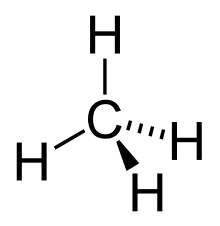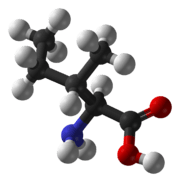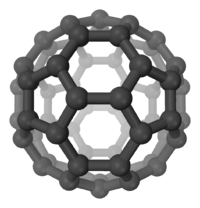Organic compound
In chemistry, organic compounds are generally any chemical compounds that contain carbon-hydrogen bonds. Due to carbon's ability to catenate (form chains with other carbon atoms), millions of organic compounds are known. The study of the properties, reactions, and syntheses of organic compounds comprises the discipline known as organic chemistry. For historical reasons, a few classes of carbon-containing compounds (e.g., carbonate anion salts and cyanide salts), along with a handful of other exceptions (e.g., carbon dioxide), are not classified as organic compounds and are considered inorganic. Other than those just named, little consensus exists among chemists on precisely which carbon-containing compounds are excluded, making any rigorous definition of an organic compound elusive.[1]

Although organic compounds make up only a small percentage of the Earth's crust, they are of central importance because all known life is based on organic compounds. Living things incorporate inorganic carbon compounds into organic compounds through a network of processes (the carbon cycle) that begins with the conversion of carbon dioxide and a hydrogen source like water into simple sugars and other organic molecules by autotrophic organisms using light (photosynthesis) or other sources of energy. Most synthetically produced organic compounds are ultimately derived from petrochemicals consisting mainly of hydrocarbons, which are themselves formed from the high pressure and temperature degradation of organic matter underground over geological timescales.[2] This ultimate derivation notwithstanding, organic compounds are no longer defined as compounds originating in living things, as they were historically.
In chemical nomenclature, an organyl group, frequently represented by the letter R, refers to any monovalent substituent whose open valence is on a carbon atom.[3]
Definitions of organic vs inorganic
For historical reasons discussed below, a few types of carbon-containing compounds, such as carbides, carbonates, simple oxides of carbon (for example, CO and CO2), and cyanides are considered inorganic. Different forms (allotropes) of pure carbon, such as diamond, graphite, fullerenes, and carbon nanotubes[4] are also excluded because they are simple substances composed of only a single element and therefore are not generally considered to be chemical compounds.
History
Vitalism
Vitalism was a widespread conception that substances found in organic nature are created from the chemical elements by the action of a "vital force" or "life-force" (vis vitalis) that only living organisms possess. Vitalism taught that these "organic" compounds were fundamentally different from the "inorganic" compounds that could be obtained from the elements by chemical manipulations.
Vitalism survived for a while even after the rise of modern ideas about the atomic theory and chemical elements. It first came under question in 1824, when Friedrich Wöhler synthesized oxalic acid, a compound known to occur only in living organisms, from cyanogen. A further experiment was Wöhler's 1828 synthesis of urea from the inorganic salts potassium cyanate and ammonium sulfate. Urea had long been considered an "organic" compound, as it was known to occur only in the urine of living organisms. Wöhler's experiments were followed by many others, in which increasingly complex "organic" substances were produced from "inorganic" ones without the involvement of any living organism.[5]
Modern classification and ambiguities

Although vitalism has been discredited, scientific nomenclature retains the distinction between organic and inorganic compounds. The modern meaning of organic compound is any compound that contains a significant amount of carbon—even though many of the organic compounds known today have no connection to any substance found in living organisms. The term carbogenic has been proposed by E. J. Corey as a modern alternative to organic, but this neologism remains relatively obscure.
The organic compound L-isoleucine molecule presents some features typical of organic compounds: carbon–carbon bonds, carbon–hydrogen bonds, as well as covalent bonds from carbon to oxygen and to nitrogen.
As described in detail below, any definition of organic compound that uses simple, broadly applicable criteria turns out to be unsatisfactory, to varying degrees. The modern, commonly accepted definition of organic compound essentially amounts to any carbon containing compound, excluding several classes of substances traditionally considered as 'inorganic'. However, the list of substances so excluded varies from author to author. Still, it is generally agreed upon that there are (at least) a few carbon containing compounds that should not be considered organic. For instance, almost all authorities would require the exclusion of alloys that contain carbon, including steel (which contains cementite, Fe3C), as well as other metal and semimetal carbides (including "ionic" carbides, e.g, Al4C3 and CaC2 and "covalent" carbides, e.g. B4C and SiC, and graphite intercalation compounds, e.g. KC8). Other compounds and materials that are considered 'inorganic' by most authorities include: metal carbonates, simple oxides (CO, CO2, and arguably, C3O2), the allotropes of carbon, cyanide derivatives not containing an organic residue (e.g., KCN, (CN)2, BrCN, CNO−, etc.), and heavier analogs thereof (e.g., CP− 'cyaphide anion', CSe2, COS; although CS2 'carbon disulfide' is often classed as an organic solvent). Halides of carbon without hydrogen (e.g., CF4 and CClF3), phosgene (COCl2), carboranes, metal carbonyls (e.g., nickel carbonyl), mellitic anhydride (C12O9), and other exotic oxocarbons are also considered inorganic by some authorities.
Nickel carbonyl (Ni(CO)4) and other metal carbonyls present an interesting case. They are often volatile liquids, like many organic compounds, yet they contain only carbon bonded to a transition metal and to oxygen and are often prepared directly from metal and carbon monoxide. Nickel carbonyl is frequently considered to be organometallic. Although many organometallic chemists employ a broad definition, in which any compound containing a carbon-metal covalent bond is considered organometallic, it is debatable whether organometallic compounds form a subset of organic compounds.[6]
Metal complexes with organic ligands but no carbon-metal bonds (e.g., Cu(OAc)2) are not considered organometallic; instead they are classed as metalorganic. Likewise, it is also unclear whether metalorganic compounds should automatically be considered organic.
The relatively narrow definition of organic compounds as those containing C-H bonds excludes compounds that are (historically and practically) considered organic. Neither urea nor oxalic acid is organic by this definition, yet they were two key compounds in the vitalism debate. The IUPAC Blue Book on organic nomenclature specifically mentions urea[7] and oxalic acid.[8] Other compounds lacking C-H bonds but traditionally considered organic include benzenehexol, mesoxalic acid, and carbon tetrachloride. Mellitic acid, which contains no C-H bonds, is considered a possible organic substance in Martian soil.[9] Terrestrially, it, and its anhydride, mellitic anhydride, are associated with the mineral mellite (Al2C6(COO)6·16H2O).
A slightly broader definition of organic compound includes all compounds bearing C-H or C-C bonds. This would still exclude urea. Moreover, this definition still leads to somewhat arbitrary divisions in sets of carbon-halogen compounds. For example, CF4 and CCl4 would be considered by this rule to be "inorganic", whereas CF3H, CHCl3, and C2Cl6 would be organic, though these compounds share many physical and chemical properties.
Classification
Organic compounds may be classified in a variety of ways. One major distinction is between natural and synthetic compounds. Organic compounds can also be classified or subdivided by the presence of heteroatoms, e.g., organometallic compounds, which feature bonds between carbon and a metal, and organophosphorus compounds, which feature bonds between carbon and a phosphorus.
Another distinction, based on the size of organic compounds, distinguishes between small molecules and polymers.
Natural compounds
Natural compounds refer to those that are produced by plants or animals. Many of these are still extracted from natural sources because they would be more expensive to produce artificially. Examples include most sugars, some alkaloids and terpenoids, certain nutrients such as vitamin B12, and, in general, those natural products with large or stereoisometrically complicated molecules present in reasonable concentrations in living organisms.
Further compounds of prime importance in biochemistry are antigens, carbohydrates, enzymes, hormones, lipids and fatty acids, neurotransmitters, nucleic acids, proteins, peptides and amino acids, lectins, vitamins, and fats and oils.
Synthetic compounds
Compounds that are prepared by reaction of other compounds are known as "synthetic". They may be either compounds that already are found in plants or animals or those that do not occur naturally.
Most polymers (a category that includes all plastics and rubbers) are organic synthetic or semi-synthetic compounds.
Biotechnology
Many organic compounds—two examples are ethanol and insulin—are manufactured industrially using organisms such as bacteria and yeast. Typically, the DNA of an organism is altered to express compounds not ordinarily produced by the organism. Many such biotechnology-engineered compounds did not previously exist in nature.
Databases
- The CAS database is the most comprehensive repository for data on organic compounds. The search tool SciFinder is offered.
- The Beilstein database contains information on 9.8 million substances, covers the scientific literature from 1771 to the present, and is today accessible via Reaxys. Structures and a large diversity of physical and chemical properties is available for each substance, with reference to original literature.
- PubChem contains 18.4 million entries on compounds and especially covers the field of medicinal chemistry.
A great number of more specialized databases exist for diverse branches of organic chemistry.
Structure determination
The main tools are proton and carbon-13 NMR spectroscopy, IR Spectroscopy, Mass spectrometry, UV/Vis Spectroscopy and X-ray crystallography.[10]
See also
- Inorganic compounds
- List of chemical compounds
- List of organic compounds
- Organometallic compounds
References
- Spencer L. Seager, Michael R. Slabaugh. Chemistry for Today: general, organic, and biochemistry. Thomson Brooks/Cole, 2004, p. 342. ISBN 0-534-39969-X
- Smith, Cory. "Petrochemicals". American Fuel & Petrochemical Manufacturers. American Fuel & Petrochemical Manufacturers. Retrieved 18 December 2016.
- IUPAC, Compendium of Chemical Terminology, 2nd ed. (the "Gold Book") (1997). Online corrected version: (2006–) "organyl groups". doi:10.1351/goldbook.O04329
- Fullerene derivatives are more frequently considered to be organic, and fullerene chemistry is usually considered a branch of organic chemistry. Moreover, the methods of organic synthesis have been applied to the rational synthesis of fullerenes and carbon nanotubes.
- Henry Marshall Leicester; Herbert S. Klickstein (1951). A Source Book in Chemistry, 1400-1900. Harvard University Press. p. 309.
- For example, since there is evidence of covalent Fe-C bonding in cementite (https://aip.scitation.org/doi/10.1063/1.2884529), a major component of steel, the broad definition would result in the classification of this compound as organometallic. However, steel and other carbon-containing alloys are seldom regarded as organic compounds. Thus, it is unclear whether the definition of organometallic should be narrowed, and/or whether these considerations imply that organometallic compounds are not necessarily organic.
- "IUPAC Blue Book, Urea and Its Derivatives Rule C-971". Retrieved 2009-11-22.
- "IUPAC Blue Book, Table 28(a) Carboxylic acids and related groups. Unsubstituted parent structures". Retrieved 2009-11-22.
- S. A. Benner; K. G. Devine; L. N. Matveeva; D. H. Powell (2000). "The missing organic molecules on Mars". Proceedings of the National Academy of Sciences. 97 (6): 2425–2430. Bibcode:2000PNAS...97.2425B. doi:10.1073/pnas.040539497. PMC 15945. PMID 10706606.
- Ernö Pretsch, Philippe Bühlmann, Martin Badertscher (2009), Structure Determination of Organic Compounds (Fourth, Revised and Enlarged Edition). Springer-Verlag Berlin Heidelberg
